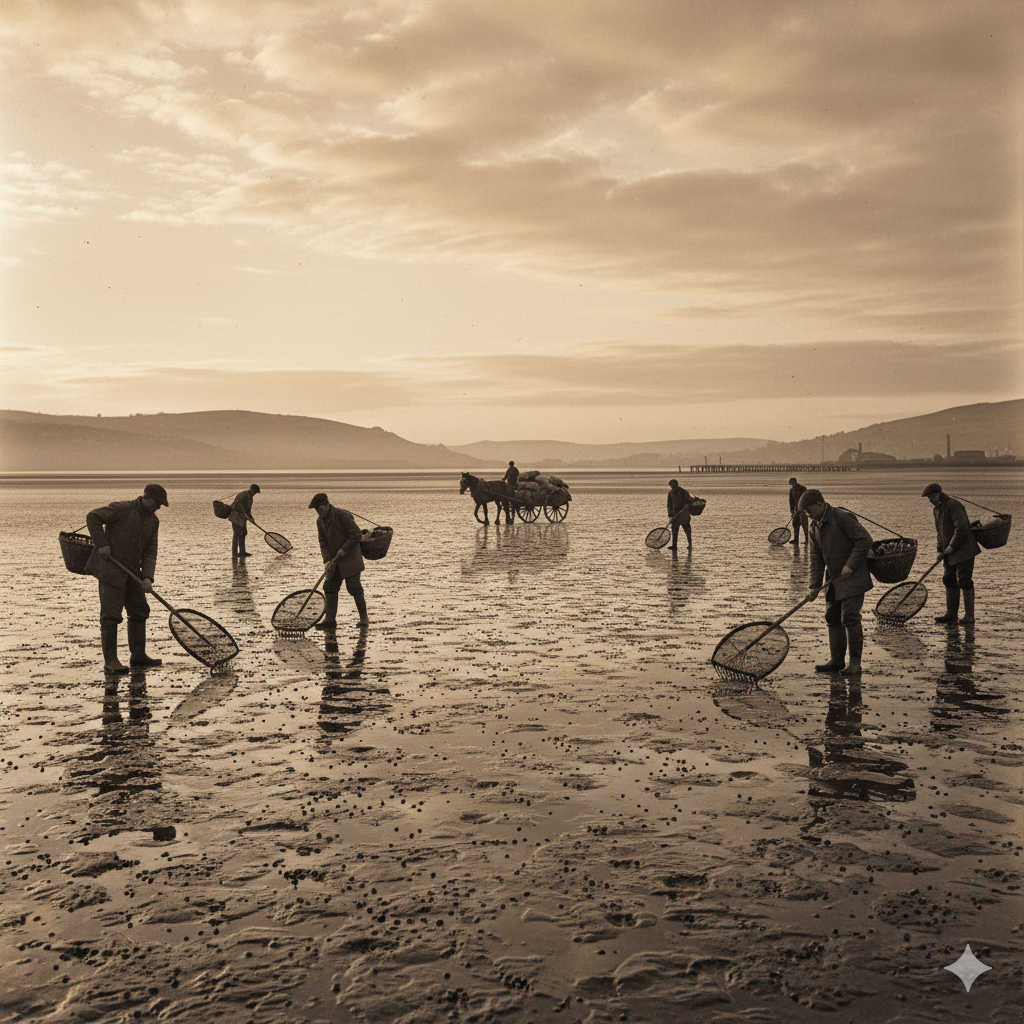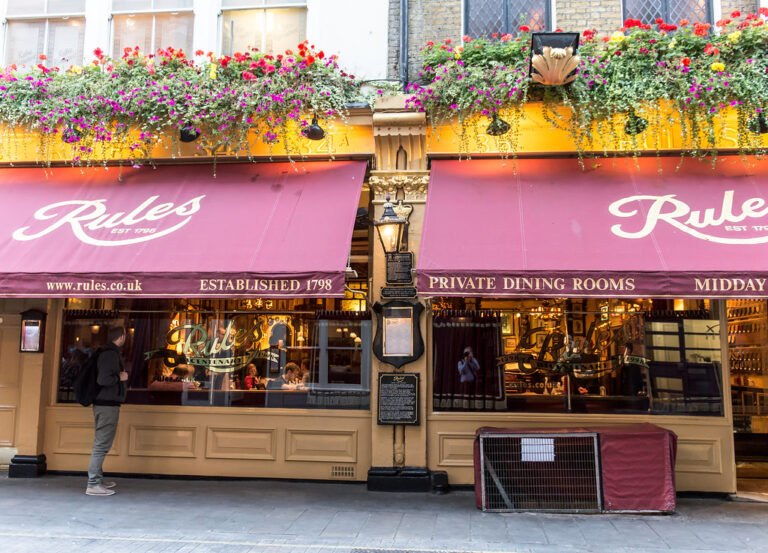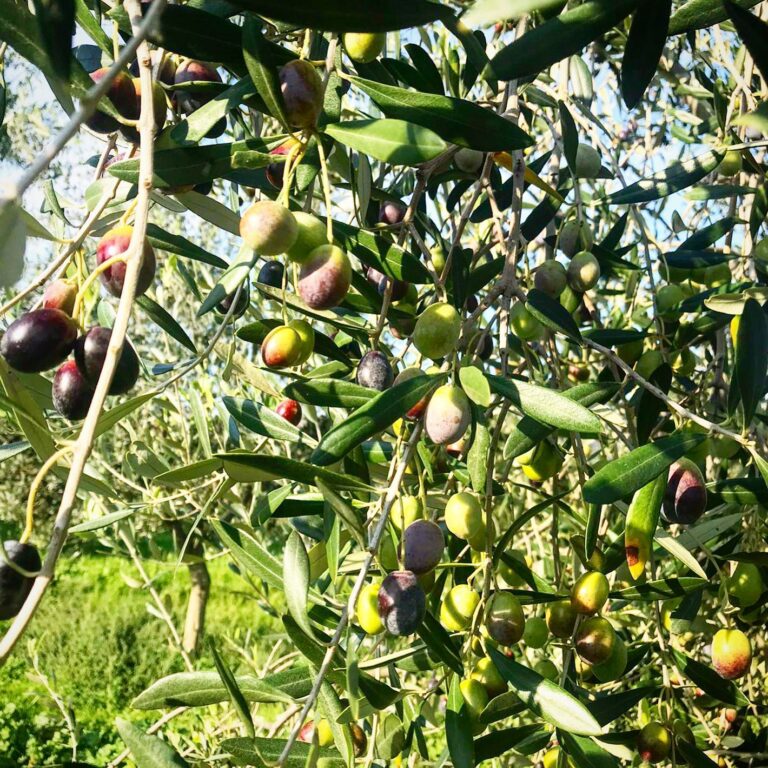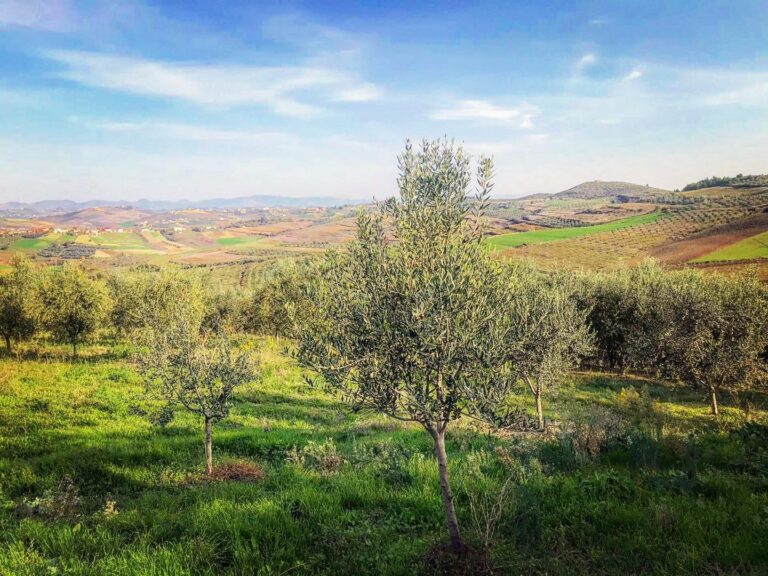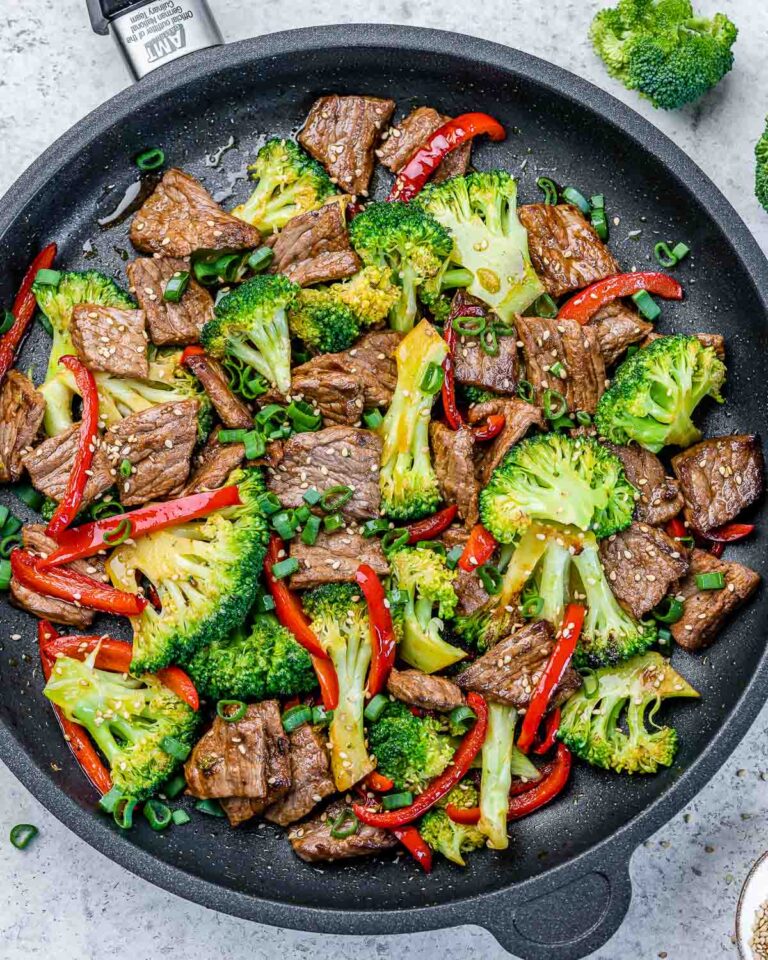The Taste of the Tide: A History of Foraging and Fishing on the South Wales Coast
The Crucible of the Coast
The coastline of South Wales is a landscape of dramatic contrasts. To the west, the Gower Peninsula extends into the Bristol Channel, its southern edge defined by formidable limestone cliffs and secluded bays, while its northern shore dissolves into the vast, tidal expanse of the Burry Inlet and the Loughor Estuary. This unique geography, poised between the pastoral uplands of the Welsh interior and the burgeoning industrial heartlands of Swansea and the valleys, forged a resilient and distinctive coastal food culture. For centuries, the people of this region have lived by the rhythm of the tides, harvesting a unique bounty from the shoreline that became synonymous with Welsh identity.
This report chronicles the history of that culture through three of its most iconic elements: the cliff-hanging samphire, the nutrient-rich laverbread, and the world-renowned cockles of the Burry Inlet. These were not merely foods; they were characters in the story of South Wales—a story of survival, arduous labor, and deep-rooted community. The traditional Welsh diet was one of simple, wholesome fare, designed to satisfy the hearty appetites of a people working the land and sea: farmers, quarry workers, coal miners, and fishermen.1 The Gower Peninsula, historically difficult to access by land, fostered a particularly distinct cuisine born of its relative isolation and its rich coastal resources.3
The coastal food culture of South Wales thus occupied a unique position, a bridge between an ancient, pre-industrial mode of subsistence and the voracious new economy of the industrial age. It was the harvest of the past that fueled the engines of the future. The story of these foods is a powerful lens through which to understand the profound social, economic, and cultural transformations that shaped modern Wales, demonstrating an enduring connection between a people and the tides that defined their lives.
Part I: The Forager’s Bounty – Sustenance from the Shoreline
Chapter 1: The Dreadful Trade – Rock Samphire on the Gower Cliffs
Long before it became a fashionable garnish in modern restaurants, samphire was a plant of profound historical and economic significance, its story rooted in the perilous cliffs of the British coastline. The original and most prized variety was Rock Samphire (Crithmum maritimum), a fleshy, aromatic perennial that thrives in the crevices of sea-facing rocks, just above the high-tide line.4 Its harvest was a dangerous occupation, immortalized by William Shakespeare in
King Lear in 1606. From the cliffs of Dover, a location Shakespeare was said to be familiar with, the character Edgar describes a harrowing scene: “Halfway down hangs one that gathers samphire, dreadful trade!”.6 This single line has echoed through centuries, encapsulating the life-threatening risks undertaken by impoverished coastal communities to gather this valuable plant.8
The name “samphire” itself is a testament to its coastal habitat, a corruption of the French “Herbe de Saint Pierre” or St. Peter’s Herb, named for the patron saint of fishermen who work in the same salt-sprayed regions.7 Its consumption dates back to antiquity. The Greek physician Dioscorides recorded its use in the first century, and it was a familiar, humble dish throughout the Roman Empire, whose legions once occupied the Gower.4 For centuries, Rock Samphire was a well-known commodity. An 1844 guidebook lists it as one of the key products of the south Gower seashore, alongside limestone and oysters.8 Gatherers, often men and boys dangling from ropes, would collect the tender spring growth, which was then pickled in barrels of brine and transported to cities like London, where it was served as a piquant accompaniment to meat.4
Beyond its culinary appeal, Rock Samphire was highly valued for its nutritional properties. It is a rich source of Vitamin C, a fact that made it a crucial defense against scurvy on long sea voyages.4 Its importance to maritime life is underscored by an entry in the diary of Samuel Pepys; on September 21, 1660, the famed diarist and naval administrator received a barrel of samphire as a gift from the clerk of the Victualler of the Navy, a clear indication of its status as a vital provision.5
However, the very popularity that made Rock Samphire a valuable commodity led to its downfall. Centuries of intensive harvesting took their toll. By the last quarter of the 19th century, a period that also saw the catastrophic depletion of the once-abundant oyster beds in Swansea Bay, Rock Samphire was described as being scarce at market.5 The public had not lost its taste for the plant; rather, the natural sources had been exhausted by the demands of a trade that had become unsustainable.
This scarcity created a market vacuum that was soon filled by a substitute, giving rise to a botanical and culinary confusion that persists to this day. With the prized cliff-dweller in short supply, merchants began to bulk out their barrels with, or substitute it entirely for, a different plant: Marsh Samphire (Salicornia europaea), also known as glasswort.4 This unrelated plant grew in abundance on the upper edges of salt marshes and estuaries, making it far easier and safer to harvest.4 Marsh Samphire had its own distinct history, not primarily as a food but as an industrial raw material. Its high concentration of sodium carbonate, or soda ash, made it a key ingredient in the glass and soap industries since the 14th century, hence the name “glasswort”.5 Over time, as the substitute became more common, it appropriated the name of the original. The term “samphire” became a brand that was effectively transferred from a depleted, wild-harvested delicacy to an abundant, more accessible commodity. Today, the samphire most commonly found in shops and restaurants is the marsh variety, a direct legacy of the economic pressures that drove the “dreadful trade” of Rock Samphire to the brink of commercial extinction.4
Chapter 2: Welshman’s Caviar – The Story of Laverbread (Bara Lawr)
Of all the foods harvested from the Welsh coast, none is more iconic or more deeply woven into the fabric of the nation’s identity than laverbread, or bara lawr. This dark, savory puree of seaweed is a true taste of the Welsh sea, a product of ancient tradition that became the very fuel of the industrial revolution. The practice of eating laver seaweed is ancient, with some speculating it may have been a survival food for the very first inhabitants of Wales or introduced by Viking raiders.10 The first definitive written accounts, however, appear in the 12th century from the chronicler Giraldis Cambrensis (Gerald of Wales) during his travels through Pembrokeshire.10
A more vivid description is found in William Camden’s 1607 historical survey, Britannia. He documents the springtime gathering of “Lhawvan” near St David’s, a tradition further detailed in a 1695 edition of the work.2 The process described was laborious and specific. The seaweed,
Porphyra umbilicalis—a unique red algae whose delicate fronds are only one cell thick—was plucked from the rocks along the shoreline.12 It was then meticulously washed to remove sand and slime before being “sweated” or drained between two flat stones. This processed weed was then shredded and kneaded like dough into large balls or rolls, which were known in English as “black butter”.10 It could be eaten raw, but was more commonly fried with oatmeal and butter.10
For centuries, laverbread remained a local coastal delicacy, valued for its purported medicinal properties; it was considered “sovereign against all distempers of the liver and spleen” and was even said to provide relief from kidney stones.10 Its destiny, however, was to be transformed by the seismic economic shifts of the 18th and 19th centuries. As the coal pits of the South Wales valleys began to power Britain’s industrial might, laverbread became a staple food for the miners.11 This was no accident. The work was grueling, and the miners required a diet that was both high in energy and rich in nutrients. Laverbread was a nutritional powerhouse, packed with protein, iodine, vitamin C, and, crucially, iron.13 Its value was so well understood that doctors would prescribe it to worn-out miners and to the often-malnourished women and children who also worked in the pits, to combat exhaustion and deficiency diseases.13
This relationship between the seaweed and the mining community represents a profound example of biocultural heritage. A specific biological resource, Porphyra umbilicalis, became inextricably linked to the cultural identity and economic survival of a people. The food was a symbol of the miners’ resilience and, by extension, became a core part of modern Welsh working-class identity. Swansea, with its bustling market and close proximity to both the Gower coast and the industrial valleys, emerged as the “laverbread mecca”.11 Here, it was often sold alongside cockles hauled by donkey cart from the nearby Burry Inlet, solidifying the classic culinary pairing that remains a cornerstone of the traditional Welsh breakfast.11
In the 20th century, laverbread’s cultural status was cemented by its association with actor Richard Burton, who famously dubbed it the “Welshman’s Caviar”.12 While some sources suggest this memorable phrase was actually a clever marketing invention by the pioneering Welsh food writer Bobby Freeman, the title has stuck, elevating the humble seaweed to the level of a national delicacy.10 Though demand declined with the coal industry in the mid-20th century, laverbread has enjoyed a renaissance.11 In 2017, in recognition of its deep, historical connection to the place, the organism, and the people, Welsh Laverbread was awarded Protected Designation of Origin (PDO) status, a modern legal framework designed to protect this ancient and enduring link.13
Part II: The Cockle Women of Penclawdd – An Estuary’s Enduring Industry
Chapter 3: An Industry Built by Women
The vast, sandy flats of the Burry Inlet, exposed at low tide, have been a source of sustenance since Roman times.16 For centuries, this estuary has been home to a thriving cockle industry, but its history is unique in that it was an economy built, sustained, and dominated by women. By the 19th century, hundreds of “cockle women” could be seen scattered across the sands, icons of Welsh culture known for their unmistakable traditional dress of red and black flannel, their resilience, and the back-breaking nature of their work.18
The cockle industry of Penclawdd and the surrounding villages functioned as a distinct matrifocal, or female-centered, micro-economy. It operated in parallel to the patriarchal heavy industries of coal and steel that defined much of South Wales, representing a rare sphere of female economic power and autonomy. The income from cockling provided these women with an unusual degree of financial independence for the era.18 Many were the primary breadwinners, supporting husbands who were injured or unemployed after accidents in the local mines, while widows raised their children single-handedly on the earnings from their harvest.18 This was not merely “women’s work” in a supplementary sense; it was a foundational economic system for the community, controlled and executed by women, and it profoundly shaped the local social structure.18
The work itself was grueling. In the early hours, often before sunrise, the women would follow the receding tide, walking up to ten miles to reach their preferred cockle beds.18 There, they would spend hours bent double, using a hand-rake to scrape the shellfish from the heavy sand and a large circular sieve, known as a riddle, to separate the mature cockles from the undersized and the debris.18 Carol Watts, whose family has sold cockles at Swansea Market for generations, described the labor starkly to the BBC: “It was rough, very back-breaking, very wet, a hard job. The women did it to put bread on the tables, things were tough”.18
The trade was also fraught with danger. The tides of the Burry Inlet are swift and treacherous, and the women had to possess an intimate knowledge of the shifting sands and deep channels that could cut off their path back to shore. A delay to gather one extra bag could be a fatal miscalculation. This constant peril was tragically illustrated in December 1937, when Mary Pamp and a friend were overtaken by the returning tide and carried out to sea. Their bodies washed ashore in Penclawdd a few days later, a stark reminder of the risks inherent in their daily labor.18
Once safely ashore, the work continued. The women washed and boiled the cockles in large pots over rudimentary stone fireplaces, either on the shoreline or outside their homes. After boiling, the meat was painstakingly removed from the shells.18 Over time, great mounds of empty, discarded cockle shells became a distinctive feature of the local landscape, a testament to the scale of the industry and the generations of women who powered it.18
Chapter 4: The Cockle Line – From Burry Inlet to the World
The journey of the Penclawdd cockle from the sands of the estuary to the tables of consumers is a story of transformation, driven by infrastructure and entrepreneurial spirit. In the era before modern transport, the reach of the industry was limited by the physical endurance of the cockle women themselves. Each Saturday, they would undertake the arduous nine-mile walk to Swansea Market, balancing heavy baskets of freshly cooked cockles on their heads.18 To preserve their precious shoes for the town, they walked the long road barefoot, only stopping at a stream on the outskirts of Swansea known as “Olchfa” (the washing place) to bathe their feet before putting their boots on to enter the market.18 The product was inextricably tied to its immediate geography.
This all changed with the arrival of the railway in Penclawdd in 1867. The branch line from Gowerton, though built primarily to transport locally mined coal, was affectionately nicknamed the “Cockle Line” for the revolutionary impact it had on the shellfish trade.18 The railway acted as an artery, breaking the geographical constraints that had long defined the industry. It allowed fresh cockles to be transported quickly and in vast quantities to the industrial towns of the South Wales Valleys and as far afield as Birmingham.19
This new infrastructure did more than just transport a product; it was a powerful conduit for cultural dissemination. The primary destinations for the cockles were industrial centers with large populations of Welsh migrants who had left their coastal or rural homes for work. For these displaced communities, the arrival of fresh cockles and laverbread was not just food; it was a taste of home, a tangible link to the culture and place they had left behind. The railway thus helped to transform a hyper-local subsistence food into a regional delicacy and a cherished symbol of Welsh identity far beyond the shores of the Burry Inlet.
The industry continued to evolve. Donkeys, which had been used for generations to haul the heavy sacks across the sand, were gradually replaced by horses and carts in the 1920s and 1960s, and today the harvesting is done using 4×4 vehicles and tractors.16 By the 1970s, what was once a female-dominated industry had largely shifted to men, and Penclawdd cockles were being exported internationally, enjoyed in Spanish paella and shipped as far as North America and Africa.18 To ensure the fishery’s future, a government decree was passed in 1965 to regulate the harvest, ending the previous “free-for-all” and establishing a system of licensed quotas.16 Today, the Burry Inlet cockle fishery is one of the largest in the UK and was the first bivalve fishery in the world to achieve Marine Stewardship Council (MSC) certification for its sustainable practices.20
Despite its success, the industry has faced significant challenges. Pollution in the estuary has at times threatened cockle stocks.16 Furthermore, a persistent shadow hangs over the inlet from the Second World War, when the military conducted secret biowarfare experiments, dropping at least one anthrax bomb over the north Gower salt marshes in 1942.17 Although official reports in the 1980s claimed the tides had decontaminated the area, mass cockle die-offs as recently as 2009 have reignited local fears and debate about potential long-term contamination.17
Part III: A Comparative Palate – Coastal Diets of Wales and Albania
Chapter 5: Echoes Across the Seas
To fully appreciate the unique character of the Welsh coastal diet, it is instructive to compare it with that of another European nation with a rich and distinct coastal food culture: Albania. Situated on the Adriatic and Ionian Seas, Albania’s culinary traditions, like those of Wales, are deeply connected to its landscape. However, a comparative analysis reveals how profoundly different historical, geographical, and political forces can shape two food cultures, which nevertheless faced convergent threats in the modern era.
The traditional diet of coastal Wales was forged in relative isolation, shaped primarily by ancient Celtic pastoral traditions and the later demands of the British Industrial Revolution.1 Its core ingredients were the products of a pastoral and subsistence economy: lamb and mutton from the hills, heavily salted pork, beef, and dairy products like butter and cheese.2 Grains such as oats and barley were staples, along with hardy vegetables like leeks and cabbage. The coast provided a vital supplement in the form of shellfish and seaweed.2 The resulting flavor profile was simple, hearty, and wholesome—fuel designed for hard manual labor, with a strong emphasis on salting for preservation.1
Albanian cuisine, by contrast, developed at a vibrant crossroads of empires. Its 2,000-year history has been influenced by Mediterranean neighbors like Greece and Rome, by broader Balkan traditions, and most significantly, by centuries of rule under the Ottoman Empire.22 The coastal diet emphasizes fresh seafood, lamb, and goat, but its character is defined by a Mediterranean palate of olive oil, garlic, yogurt, and fresh vegetables like peppers, tomatoes, and eggplant.22 Ottoman influence is evident in staples like
qofte (meatballs), savory pastries (byrek), and sweet phyllo desserts like bakllava.22 The flavor profile is a complex blend of Mediterranean freshness and Ottoman richness, with an emphasis on grilling, stews, and the liberal use of herbs.22
While their origins are vastly different, the traditional foodways of both nations faced existential threats in the 20th century, born of powerful, top-down political and economic systems. In Wales, the challenge came from capitalist industrial decline and globalization. As the coal mines closed and the heavy industries shrank, the communities that had relied on foods like laverbread and cockles were dispersed or impoverished. Simultaneously, the rise of mass-produced, processed foods threatened to displace traditional dishes from the Welsh diet.11
In Albania, the threat was political and absolute. A half-century of brutal, isolationist communist dictatorship under Enver Hoxha systematically dismantled the country’s traditional gastronomy. Acute poverty, state control of agriculture, and forced collectivization destroyed the ecosystem of small farmers and artisan producers who were the pillars of the cuisine.23 Following the collapse of communism, a chaotic transition and the sudden influx of globalized food systems posed further challenges to preserving the nation’s culinary heritage.23
Thus, two nations with divergent histories faced convergent threats. Both the market-driven decline of industry in Wales and the state-driven destruction of agriculture in Albania had a similar effect: they disrupted the local, traditional ecosystems of food production and consumption. The post-industrial and post-communist eras have, in parallel, seen a concerted effort in both countries to reclaim and revitalize a rich culinary history in the face of modern pressures. This shared struggle to preserve a unique food identity is a profound and unexpected link between these two distinct European coastlines.
Table 1: Comparative Analysis of Traditional Coastal Diets (Wales vs. Albania)
| Feature | Traditional Coastal Wales | Traditional Coastal Albania |
| Primary Proteins | Shellfish (cockles, mussels), Lamb/Mutton, Salted Pork/Bacon | Seafood (various fish), Lamb, Goat |
| Staple Grains & Veg | Oats, Barley, Leeks, Cabbage, Seaweed (Laver) | Wheat (for bread/pastry), Peppers, Eggplant, Tomatoes, Olives |
| Key Flavorings/Fats | Salt, Butter, Mint, Thyme | Olive Oil, Garlic, Yogurt, Oregano, Mint |
| Dominant Historical Influences | Celtic, Pastoral Isolation, British Industrial Revolution | Mediterranean (Greek/Roman), Balkan, Ottoman Empire |
| Preservation Methods | Heavy Salting (meat, butter), Pickling (samphire, cockles) | Drying (fruits, herbs), Curing (meats), Preserving in Olive Oil |
| Iconic Coastal Dish | Laverbread and Cockles on Toast | Grilled Fish with Olive Oil and Lemon |
| 20th Century Threat | Decline of heavy industry, rise of processed foods | Communist collectivization, post-communist globalization |
An Enduring Culinary Identity
The intertwined histories of samphire, laverbread, and cockles offer a uniquely powerful lens through which to understand the broader social, economic, and cultural narrative of South Wales. These foods are far more than historical artifacts or culinary curiosities; they are living symbols of a people’s relationship with a demanding coastal environment. Their story is one of adaptation, resilience, and the enduring connection between a community and the tides that shaped it.
The journey of these foods charts the course of Welsh history itself. Rock Samphire, the object of a “dreadful trade,” speaks to an era of precarious subsistence, its near-disappearance a cautionary tale of market-driven resource depletion. Laverbread’s transformation from an ancient coastal fare into the “Welshman’s Caviar” mirrors the nation’s own journey, becoming the nutritional bedrock of the industrial workforce that placed Wales at the heart of a global empire. The cockle industry of Penclawdd tells a remarkable social history, revealing a unique matrifocal economy where women held a rare degree of financial power, their grueling labor fueling a trade that would eventually reach international markets via the transformative power of the “Cockle Line.”
From humble subsistence fare, these foods have become potent symbols of regional and national identity, now protected by modern designations and celebrated in festivals. In an age of globalized and often anonymous food systems, they stand as testaments to the value of local, sustainable harvesting. They embody a story of how a specific geography, a unique set of biological resources, and the ingenuity of a people can create a culinary heritage that is not only delicious but also deeply meaningful—a true taste of the tide, carrying the flavor of history in every bite.
Works cited
- Famous Welsh food and drink – Visit Wales, accessed September 15, 2025, https://www.visitwales.com/things-do/food-and-drink/welsh-food-and-recipes/famous-welsh-food-and-drink
- Edible histories: Welsh food | Borough Market, accessed September 15, 2025, https://boroughmarket.org.uk/market-blog/edible-histories-welsh-food/
- Traditional Welsh Food and Cuisine – FamilySearch, accessed September 15, 2025, https://www.familysearch.org/en/blog/welsh-food
- Rock Samphire: one person’s kerosene is another’s ketchup …, accessed September 15, 2025, https://edibleswansea.wordpress.com/2016/01/07/rock-samphire-one-persons-kerosene-is-anothers-ketchup/
- Gareth Evans shares the long history of this salty seashore plant and explains the differences between rock and marsh samphire., accessed September 15, 2025, https://www.garethhevans.com/uploads/1/1/8/5/11855887/rock_samphire005.pdf
- What’s in a name – Samphire Hoe, accessed September 15, 2025, https://www.samphirehoe.com/about-samphire-hoe/name/
- Samphire – Wikipedia, accessed September 15, 2025, https://en.wikipedia.org/wiki/Samphire
- Rock Samphire; the ghost of plenty. – Edible Swansea, accessed September 15, 2025, https://edibleswansea.wordpress.com/2015/02/22/rock-samphire-the-ghost-of-plenty/
- History of the Irish Samphire – Trinity College Dublin, accessed September 15, 2025, https://www.tcd.ie/tceh/projects/foodsmartdublin/recipes/July_Samphire/HistoryEcology_Samphire.php
- The story of Laverbread — National Laverbread Day, accessed September 15, 2025, https://www.laverbreadday.co.uk/history
- A (VERY) BRIEF HISTORY OF LAVER SEAWEED AND LAVERBREAD IN WALES, accessed September 15, 2025, https://beachfood.co.uk/blogs/about-seaweed/laver-and-laverbread-in-wales
- Laverbread Day – British Guild of Tourist Guides, accessed September 15, 2025, https://britainsbestguides.org/blogs/laverbread-day/
- Welsh Laverbread (PDO) | Business Wales – Food and drink, accessed September 15, 2025, https://businesswales.gov.wales/foodanddrink/how-we-can-help/new-uk-geographical-indication-gi-schemes-0/welsh-laverbread-pdo
- Laverbread – Wikipedia, accessed September 15, 2025, https://en.wikipedia.org/wiki/Laverbread
- Why the Welsh eat seaweed | Wales.com, accessed September 15, 2025, https://www.wales.com/visit/food-and-drink/welsh-love-seaweed
- Penclawdd Cockles – Arca del Gusto – Slow Food Foundation, accessed September 15, 2025, https://www.fondazioneslowfood.com/en/ark-of-taste-slow-food/penclawdd-cockles/
- Penclawdd – Wikipedia, accessed September 15, 2025, https://en.wikipedia.org/wiki/Penclawdd
- The Cockle Women of Penclawdd – Swansea Scoop, accessed September 15, 2025, https://www.swanseascoop.com/p/the-cockle-women-of-penclawdd
- Penclawdd cockle fishery, Gower – History Points, accessed September 15, 2025, https://historypoints.org/index.php?page=penclawdd-cockle-fishery-gower
- Burry Inlet and Dee Estuary Cockle | Marine Stewardship Council, accessed September 15, 2025, https://www.msc.org/uk/what-we-are-doing/uk-irish-fisheries/burry-inlet-dee-estuary-cockle
- Welsh cuisine – Wikipedia, accessed September 15, 2025, https://en.wikipedia.org/wiki/Welsh_cuisine
- Discover Albania’s Culinary Gem: Traditional Foods You Must Try …, accessed September 15, 2025, https://statustest.amherst.edu/albania-food
- Albanian Gastronomy: From Identity Dilemma to Rural Renaissance – YouTube, accessed September 15, 2025, https://www.youtube.com/watch?v=rr2nKA2Oizo
